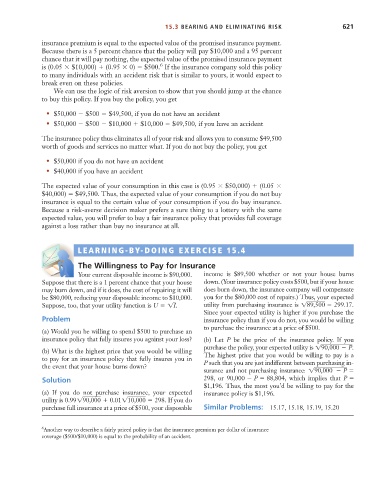Page 647 - Microeconomics, Fourth Edition
P. 647
c15riskandinformation.qxd 8/16/10 11:10 AM Page 621
15.3 BEARING AND ELIMINATING RISK 621
insurance premium is equal to the expected value of the promised insurance payment.
Because there is a 5 percent chance that the policy will pay $10,000 and a 95 percent
chance that it will pay nothing, the expected value of the promised insurance payment
6
is (0.05 $10,000) (0.95 0) $500. If the insurance company sold this policy
to many individuals with an accident risk that is similar to yours, it would expect to
break even on these policies.
We can use the logic of risk aversion to show that you should jump at the chance
to buy this policy. If you buy the policy, you get
• $50,000 $500 $49,500, if you do not have an accident
• $50,000 $500 $10,000 $10,000 $49,500, if you have an accident
The insurance policy thus eliminates all of your risk and allows you to consume $49,500
worth of goods and services no matter what. If you do not buy the policy, you get
• $50,000 if you do not have an accident
• $40,000 if you have an accident
The expected value of your consumption in this case is (0.95 $50,000) (0.05
$40,000) $49,500. Thus, the expected value of your consumption if you do not buy
insurance is equal to the certain value of your consumption if you do buy insurance.
Because a risk-averse decision maker prefers a sure thing to a lottery with the same
expected value, you will prefer to buy a fair insurance policy that provides full coverage
against a loss rather than buy no insurance at all.
LEARNING-BY-DOING EXERCISE 15.4
S
D
E
The Willingness to Pay for Insurance
Your current disposable income is $90,000. income is $89,500 whether or not your house burns
Suppose that there is a 1 percent chance that your house down. (Your insurance policy costs $500, but if your house
may burn down, and if it does, the cost of repairing it will does burn down, the insurance company will compensate
be $80,000, reducing your disposable income to $10,000. you for the $80,000 cost of repairs.) Thus, your expected
Suppose, too, that your utility function is U 1I. utility from purchasing insurance is 189,500 299.17.
Since your expected utility is higher if you purchase the
Problem insurance policy than if you do not, you would be willing
to purchase the insurance at a price of $500.
(a) Would you be willing to spend $500 to purchase an
insurance policy that fully insures you against your loss? (b) Let P be the price of the insurance policy. If you
purchase the policy, your expected utility is 190,000 P.
(b) What is the highest price that you would be willing
to pay for an insurance policy that fully insures you in The highest price that you would be willing to pay is a
P such that you are just indifferent between purchasing in-
the event that your house burns down?
surance and not purchasing insurance: 190,000 P
Solution 298, or 90,000 P 88,804, which implies that P
$1,196. Thus, the most you’d be willing to pay for the
(a) If you do not purchase insurance, your expected insurance policy is $1,196.
utility is 0.99190,000 0.01110,000 298. If you do
purchase full insurance at a price of $500, your disposable Similar Problems: 15.17, 15.18, 15.19, 15.20
6 Another way to describe a fairly priced policy is that the insurance premium per dollar of insurance
coverage ($500/$10,000) is equal to the probability of an accident.

